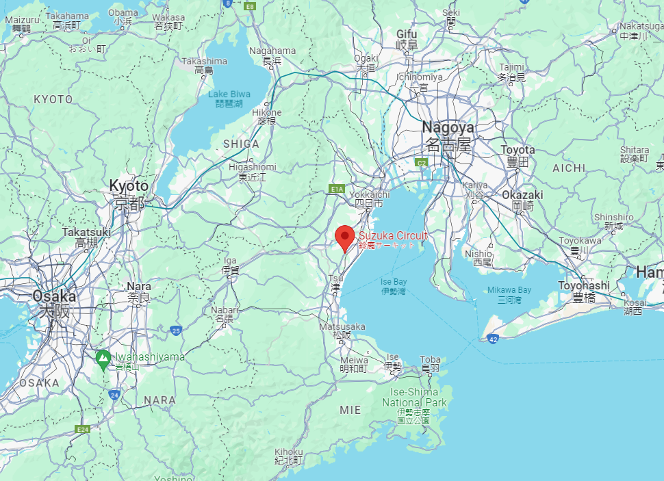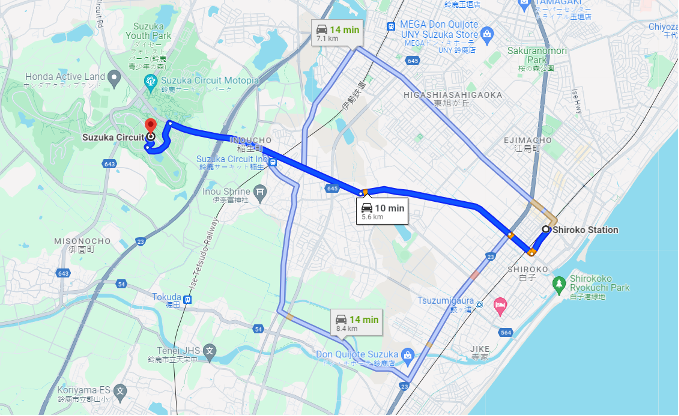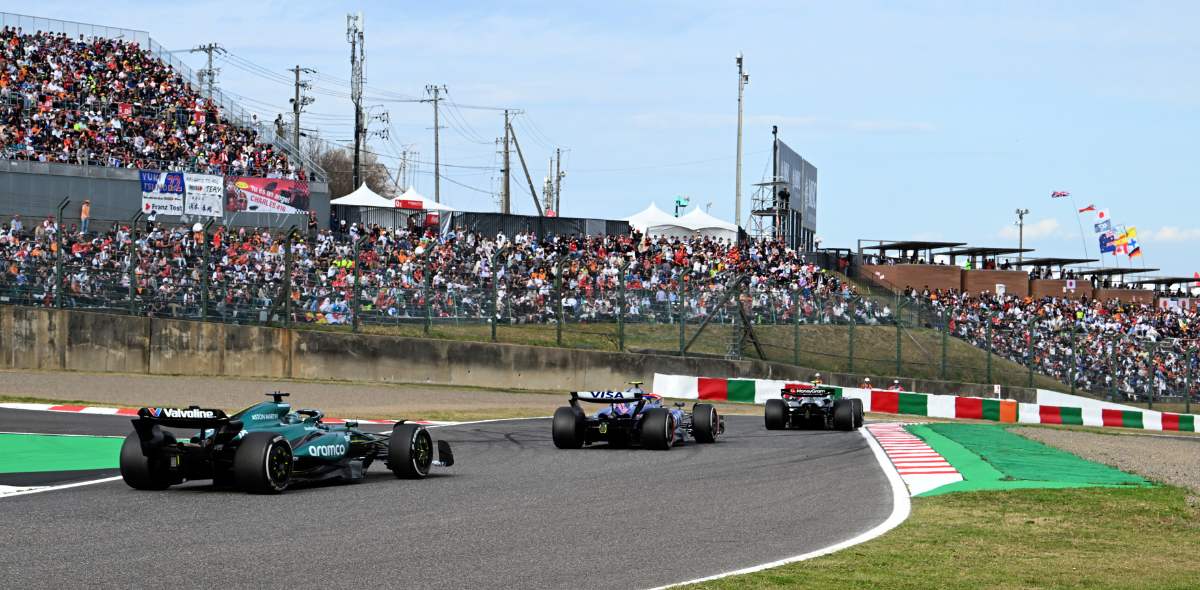There are few tracks to rival the electrifying atmosphere of the legendary Suzuka Circuit, which is why the Japanese Grand Prix is a bucket list experience for any Formula 1 fan. But unlike some races held in major city centres such as Melbourne or Barcelona, getting to Suzuka is not without a few logistical challenges, so forward planning is essential.
This comprehensive guide will equip you with essential information to plan your trip to Suzuka Circuit.
Where is Suzuka Circuit Located?
Suzuka Circuit is located in Inou, Suzuka City in the Mie Prefecture. Whilst not situated in a major metropolis itself, Suzuka is conveniently situated between the cities of Nagoya, Kyoto and Osaka.

What’s the Nearest Airport to Suzuka Circuit?
Most international flights land at Tokyo’s Narita airport (NRT) or Osaka’s Kansai airport (KIX). From North America, there are direct flights to Tokyo and Osaka from Los Angeles which take approximately 12 hours. There are also direct flights to Tokyo from Vancouver in Canada, which take approximately 10 hours.
From major European hubs – including London, Paris, Amsterdam and Frankfurt – there are direct flights to Tokyo and Osaka, which take approximately 11 hours.
From Australia, flight time to Tokyo varies between eight and 11 hours.
Please note that for most international racegoers, a whole day’s travel is usually required and travellers from Europe and the USA should factor in time to recover from jet lag ahead of the race weekend.
If you are arriving into Tokyo, there are domestic flights to Nagoya’s airport, Chubu (NGO) which is located 35.2 miles away from the circuit.
Consider using sites such Skyscanner or Google Flights to find the best options for wherever you are travelling from.
What you need to consider when deciding where to fly to for the Grand Prix
When deciding your onward journey to Suzuka from either Tokyo or Osaka, it’s worth taking the following into consideration:
Distance and cost
The distance from the airport to your accommodation and the circuit will impact travel costs. Factor in train fares, bus transfers or taxi fees.
Public transport connections
Consider how easy it is to reach Suzuka from your chosen airport city by train or bus. Research journey times and available connections.
Accommodation options
Explore both Suzuka and nearby cities for accommodation options. Staying closer to the circuit might be more convenient, but choosing to stay in cities like Nagoya or Osaka means you can make more of your trip, exploring all the wonderful culture these two hubs have to offer.
Getting to the Japanese Grand Prix by train
Japan boasts one of the most efficient and reliable train networks in the world, making it the preferred mode of transport for most fans traveling to Suzuka Circuit. It can be a little daunting stepping into your first Japanese railway station for the first time, but signs are usually in English as well as Japanese which makes it a little easier to navigate.
Tokyo and Nagoya are connected by the JR Tokaido Shinkansen line, which is the best route to take between the two cities. Travel times can vary, depending on the type of train you choose; but the journey will typically take between 1.5 – 3 hours. From Nagoya, you can connect to Yokkaichi Station via JR trains and then take the Ise Railway to Suzuka Circuit Inō Station.
Whilst not the closest station, Shikoro Station has the most convenient connections to Suzuka. Kintetsu Railway has express trains from both Nagoya and Osaka-Namba directly to Shikoro Station. The journey takes approximately 1.5 hours from either city.

Tip: Travelling by train in Japan is relatively cheap. A day ticket can cost as little as 500 yen (approx. £2.42) and 8000 yen (approx. £38.78). It’s also worth purchasing a Japan Rail Pass (JR Pass) if you are planning to spend a few days travelling round the country, with prices starting from 50,000 yen (£242.35) for a seven-day pass. Tickets for both Kintetsu and JR trains can be booked online in advance.
Travelling from Nagoya to Shikoro Station
- Take the Kintetsu Limited Express from Nagoya Station to Shikoro Station (approximately 40 minutes).
Travelling from Osaka-Namba to Shikoro Station
- Take the Kintetsu Limited Express from Osaka-Namba Station to Shikoro Station (approximately 1 hour 40 minutes).
Travelling from Kyoto to Shikoro Station:
- Take a JR train from Kyoto Station to Shin-Osaka Station.
- Transfer to the Kintetsu Limited Express from Shin-Osaka Station to Shikoro Station (total journey time: approximately 2-2.5 hours).
Travelling from Tokyo to Shikoro Station
Whilst the journey is much longer (approximately nine hours), some fans may decide to spend a day or two in Tokyo to rest up from flight and discover the sights and sounds of this incredible city.
Getting to the Japanese Grand Prix by bus
While trains are the primary mode of transport in Japan, you can also take express buses from Nagoya Station, Osaka Station, Kyoto Station and some regional stations directly to Suzuka Circuit from Friday to Sunday. A return ticket typically costs 1449 yen (approx. £7.00). The express takes around 15 minutes to get to the circuit. Information on specific routes, timetables and ticket prices are usually released closer to the event date, so keep an eye on the main circuit website for details.
Driving to Suzuka Circuit
Driving to the Japanese Grand Prix might seem appealing for its flexibility, but there are several factors and caveats to bear in mind. Parking at the Suzuka circuit is limited, especially during the Grand Prix weekend, which can pose a significant challenge. Also, while Japan drives on the left-hand side of the road (handy for UK and Australian racegoers!) and sign are in English and Japanese, navigating your way to Suzuka can be tricky for first-time attendees and you’ll need to be prepared for toll road charges on some routes. To ease these issues, a Park and Ride service is laid one during the Grand Prix weekend. This service allows you to park your car at a designated location and take a shuttle bus directly to the circuit. For more information on Park and Ride, including fees and locations, visit Suzuka Circuit Parking.
Useful tips when attending the Japanese Grand Prix
- The figure of eight track allows for great views for general admission ticket holders
- The trains in Japan are the most prompt and efficient in the world – so don’t be late!
- English is not widely spoken but ticket machines have an English language option.
- Japan is a very cash-oriented society – so bring plenty of yen with you!
- Every station train station in Japan has its own jingle and you can get to know your stop by listening to the music that plays every time you get to a station.
- People will be happy to help you out with directions but learning a handful of Japanese phrases will go a long way to show respect towards their culture.
Book tickets for the 2026 Japanese Grand Prix
Not yet bought your tickets for the 2026 Japanese Grand Prix? Tickets are on sale and you can book them via the button below.
